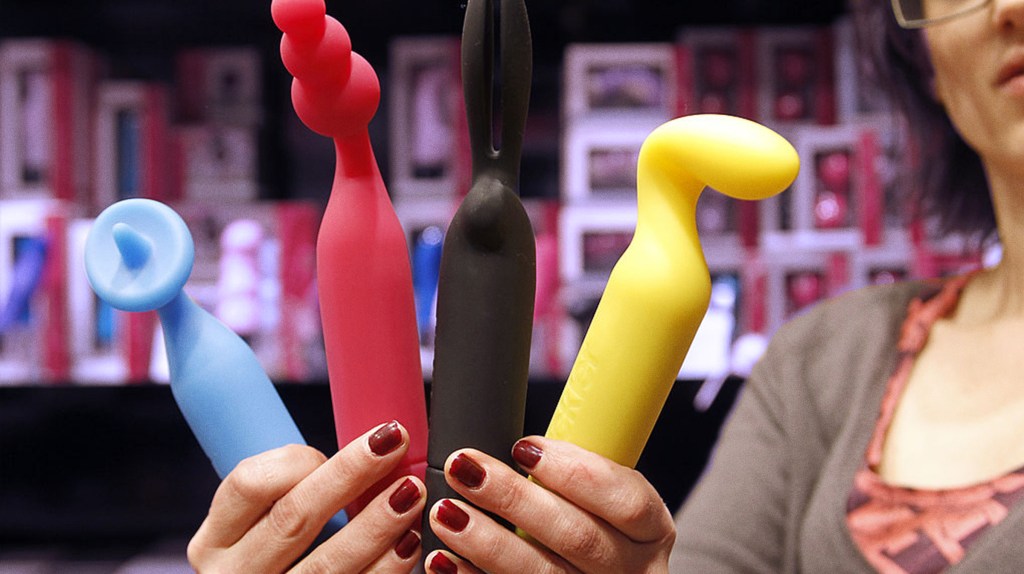I bought my first vibrator when I was 22 years old. One night after drinks, two of my female work colleagues took me to an adult sex toy store after discovering I’d never been in one. The small-town girl that I was, I gazed in awe at just the sheer variety of colorful dildos and vibrators. I ended up buying a medium-sized pink vibrating dildo—though it took me a couple of months to get over feeling intimidated. (In retrospect, I should have started with a simple egg.)
According to a new paper published in Sexual and Relationship Therapy, there are several factors a person should consider when trying to decide what kind of vibrator to purchase. The paper, courtesy of a multidisciplinary team of sexual health specialists, appears to be the first to offer evidence-based recommendations for helping health-care providers and therapists advise patients on choosing and safely using a device to aid in genital vibration, whether it’s for sexual function and/or enhancement. (These recommendations come as the result of parsing decades of research on vibrators and sexual dysfunction.)
Videos by VICE
For their part, the study’s authors acknowledge that selecting a vibrator “may feel overwhelming given the countless varieties of commercially available vibrators.” One of the first things you should consider, they write, is what you want your vibrator to actually do. If penetration and internal stimulation is important to you, then you have to look at shape and size.
“For example,” the authors write, “some vibrators that are designed specifically for external stimulation (e.g. vibrators known as bullets) are connected by wire to a remote control and thus are not recommended for internal use. Other external vibrators may not be safe for internal use due to an exposed or loose-fitting battery compartment and the need to avoid batteries being left in the vaginal canal.”
You also have to pay special attention to physical characteristics if you experience genital, anal, or pelvic pain during sex. The authors recommend avoiding mammoths and instead going for a device that is average or below average in length and circumference, and with a smooth shaft. (For reference, research cited in the paper found that the average length is less than 6 inches, while the average circumference is less than 4.5 inches.)
Additionally, if you plan to use the device anally, make sure it has a wide base or an attached string. “The incorrect use of a vibrator is the most common sexual device-related emergency in
both men and women,” the study states. “This is especially relevant for men who have sex with men, 87% of whom report anal insertion of a vibrator during self-stimulation.”
In terms of functionality, if you’re unsure of what’s going to get you off, you may want to get something that offers some versatility in speed, intensity, or type of vibration (e.g., pulsating, surging, and escalating). “Variable speed allows the patient more options and a greater opportunity to explore a speed that works best for their needs,” the study states. “Vibrators also vary in the intensity of vibration, and for some women, specifically those whose sexual function may have been impacted by aging or health conditions, a more intense vibration may be necessary for arousal and orgasm.”
Other questions you may want to ask yourself are whether or not you plan to use it with a partner—they may want to have some say in your choice of device, too—and if privacy is a concern. For example, if you’re shy and live with roommates, you may want to test out the volume of the motor before committing to a device.
Jordan Rullo, the clinical health psychologist and sex therapist who lead the study, tells Broadly the paper was inspired by her discovery of how little sexual devices had been covered in past research. “This, coupled with the fact that so many of my patients ask me how to properly use a sexual device, gave me the motivation to write this article,” she says. “Because many patients may see genital vibration as taboo, it was important to me that this article included a review of the evidence behind using genital vibration to treat sexual health concerns.”
With the exception of some safe use guideline— such as cleaning before and after use, avoiding inserting anally then vaginally or vice versa, and using lube—the authors point out that “there is no wrong way to use a vibrator” and that people “should be encouraged to explore vibrator use all over the body, not just the genitals, and be reminded that vibrator use is for both men and women.”
For More Stories Like This, Sign Up for Our Newsletter
Beyond offering recommendations on how to go about choosing the right device and how to use it safely, the study puts the onus on health care providers to teach their patients about vibrators. But recognizing that many providers don’t have the time, expertise, or feel comfortable enough to address this topic, Rullo says, they also wanted to create a source “that could simply be handed to patients with guidelines they could easily follow.”
After all, Rullo points out, “the vibrator can be used as a legitimate medical device.”
More
From VICE
-

Collage by VICE -

Collage by VICE -

Collage by VICE -

Collage by VICE
